Crossroads of the Adriatic Tour
Albania, Croatia, Montenegro, Bosnia and Herzegovina, and Slovenia
May 23 - June 12, 2015
Part Four - Bosnia and Herzegovina
Bosnia and Herzegovina is a country in SE Europe located on the Balkan Peninsula. Bordered by Croatia
to the north, west, and south, Serbia to the east, Montenegro to the southeast, and the Adriatic Sea
to the south with a coastline of about 12 miles long surrounding the city of Neum. Bosnia and Herzegovina
is a region that traces permanent human settlement back to the Neolithic age, during and after
which it was populated by several Illyrian and Celtic civilizations. Culturally, politically,
and socially, the country has one of the richest histories in the region, having been first settled by
the Slavic peoples from the 6th through to the 9th centuries AD.
It was ruled by the Ottoman Empire from the mid-15th to the late 19th centuries. This was
followed by annexation by the Austro-Hungarian Monarchy, which lasted until WWI. In the interwar period,
Bosnia was part of the Kingdom of Yugoslavia, and after WWII, it became part of the Socialist Federal
Republic of Yugoslavia. The country proclaimed independence in 1992, and the Bosnian war followed, lasting until late 1995.
Today, the country maintains high literacy, life expectancy, and education levels and is projected
to have the third highest tourism growth rate in the world between 1995 and 2020. The country is home
to three main ethnic groups. Bosniaks (Muslims) are the largest group of the three, with Serbs second (predominantly Orthodox Christians),
and Croats third (predominantly Roman Catholic). 45 percent of the population identify religiously as Muslim, 36 percent
as Serb Orthodox, 15 percent as Roman Catholic, 1 percent as Protestant, and 3 percent other. Bosnia and Herzegovina
has a bicameral legislature and a three-member Presidency composed of a member of each major ethnic group. However, the central
government's power is limited, as the country is largely decentralized and comprises two autonomous entities:
the Federation of Bosnia and Herzegovina and Republika Serpska, with a third region, the Brcko District, governed under local government.
The declaration of independence from the former Yugoslavia in March 1992 occurred after a referendum boycotted by ethnic Serbs.
The Bosnian Serbs, supported by neighboring Serbia and Montenegro, responded with armed resistance aimed at forming
a Greater Serbia. In March 1994, Bosniaks and Croats reduced the warring factions from three to two
by signing a joint Bosniak/Croat Federation of Bosnia and Herzegovina. In November 1995, the Dayton Agreement
(in Dayton, Ohio) was signed by the warring parties that more or less brought an end to the years of interethnic
and religious strife. The Dayton Agreement created a joint multi-ethnic and democratic government described above.
It appeared to me there is much discontent in the country over what is seen as an ineffective government
and shaky economy (43 % unemployment rate). In fact, stability in the whole region seems shaky. For example, a couple of
weeks before our trip, Albanian extremists clashed with Macedonian police.
Hopefully this region can overcome old and more
recent scars and become an example for ethnic and religious groups living together peacefully.
Page Seven - Pocitelj and Mostar

Neretva River Delta, an extremely fertile area of Croatia
that produces
a significant portion of Croatia's fruits and vegetables.
We drove from Dubrovnik, Croatia into Bosnia and Herzegovina

Počitelj - a walled town in Bosnia and Herzegovina located on the left bank
of the Neretva River along the road to Mostar. In 1471, following a brief
siege, Pocitelj was conquered by the Ottomans, and remained within the
Ottoman Empire until 1878. It suffered extensive damage by Croatian forces
during the war in Bosnia and Herzegovina in the 1990s, and 16th century
master works of Islamic art and architecture were destroyed, but restoration
of the buildings has taken place.

Fortress above Pocitelj

Swallow that seemed to be listening to
our tour guide's presentation on Pocitelj
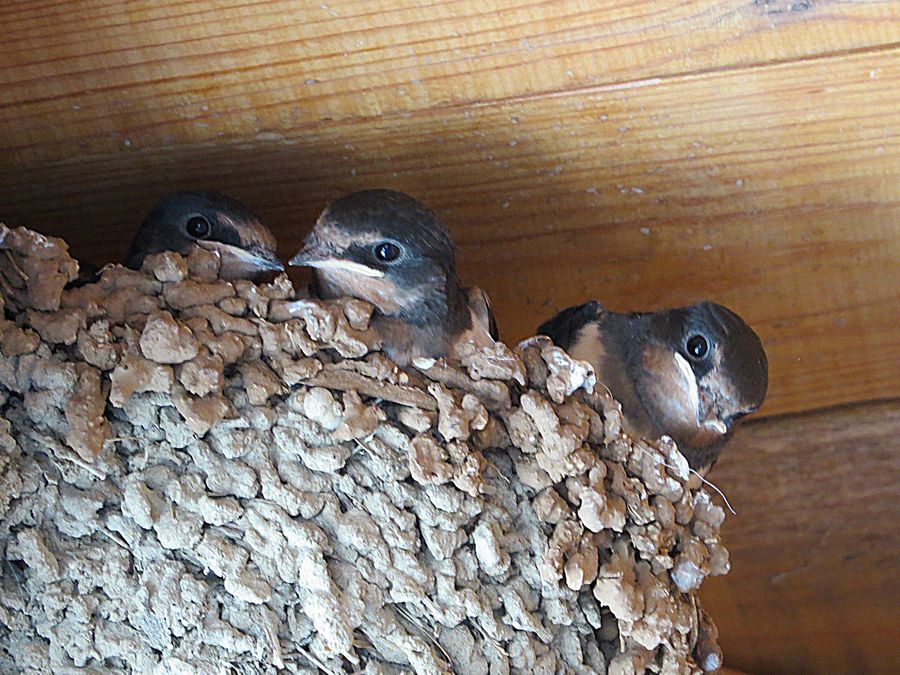
The baby swallows also seemed to be listening.
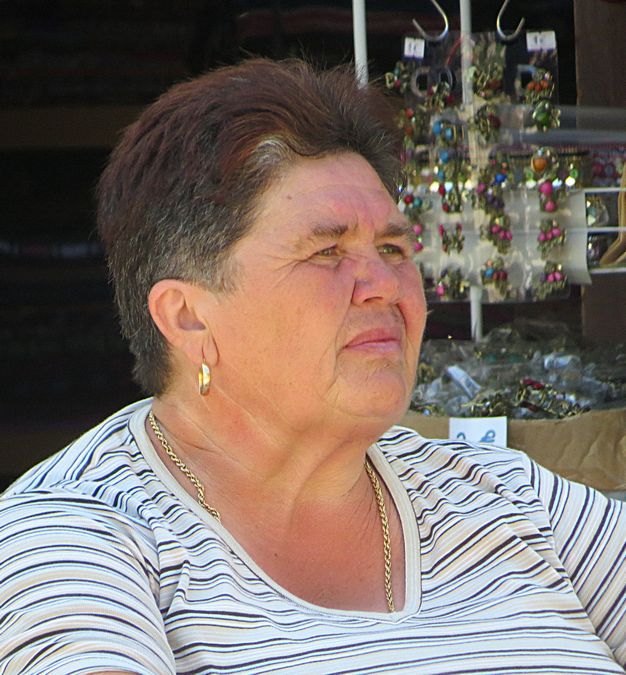
A female vendor in Pocitelj.
I bought 3 pairs of earrings in this town for a total of 5 Euro.

The mosque and Islamic architecture style buildings in Pocitelj

Mostar - a city in southern Bosnia and Herzegovina inhabited by around
113,000 people. Mostar is situated on the Neretva River and was named
after the bridge keepers (mostari) who in the medieval times guarded the
Stari Most (Old Bridge) over the Neretva. The Old Bridge, built by the
Ottomans in the 16th century, is one of Bosnia and Herzegovina's most
recognizable landmarks, is considered one of the most exemplary
pieces of Islamic architecture in the Balkans, and is perhaps Bosnia's most
recognizable architectural structure.

In the 1990s, this city of Bosniaks, Croats, and Serbs started to fall apart.
In October 1991, Bosnia & Herzegovina, following Croatia's and Slovenia's
example, but without the acceptance of its large Serb minority, began
splitting from Yugoslavia. Soon after, the Serb dominated Yugoslav
People's Army invaded. Mostar's Bosniaks and Croats joined forces to
battle the Serbs, claimed the city, and forced out Serb residents. But
as they fended off the bombardments of Serb forces, the City's Bosniaks
(Muslims) and Croats (Catholics) started to fight each other. Neighbors,
friends, even relatives fought against each other. Then,
as now, the area on the east of town was dominated by Bosniaks and the
western part of town was Croat. During the war years the Croats
on the hill laid siege to the Bosniaks (Muslims). In May 1993, Croat
forces began a 10-month siege on eastern Mostar, while in the western
part of the city, they forcibly expelled the Bosniak population from their
homes and killed hundreds. All mosques in the city were destroyed.
In November the Croats began shelling the bridge from the top of
the mountain where a Christian cross is now. The decision to destroy
the bridge was in part a symbolic attack against a bridge
representing the City's Muslim legacy.
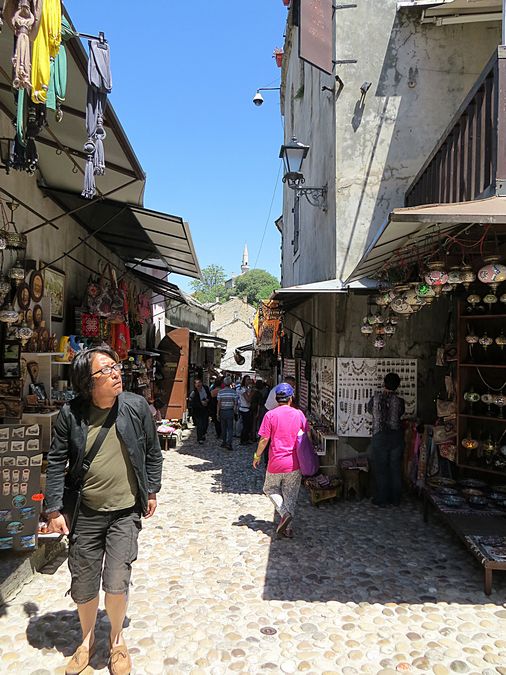
Mostar's old town area is full of souvenir shops.
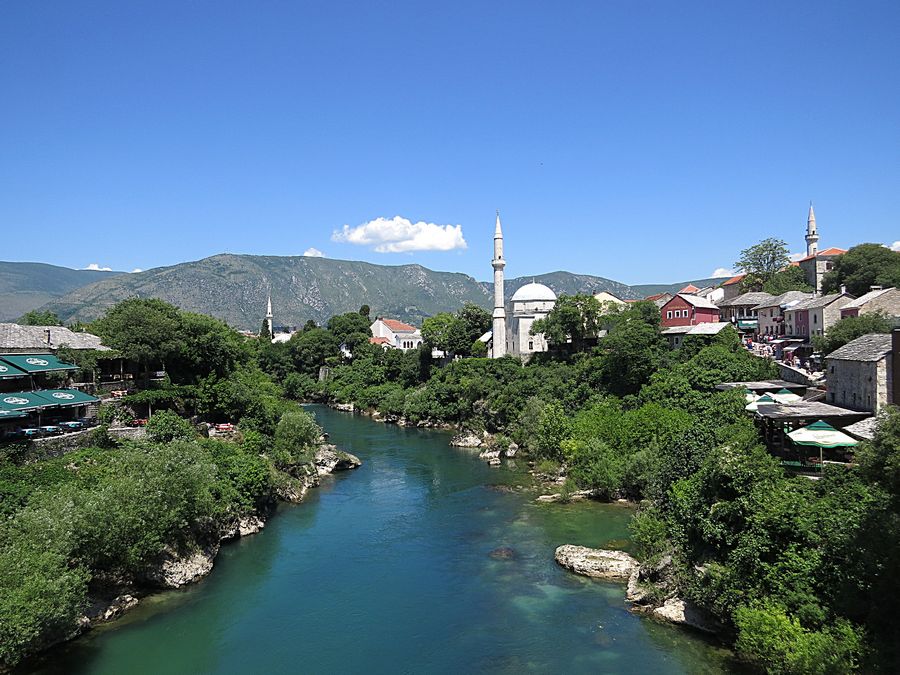
The Neretva River from Stari Most Bridge (Old Bridge)

A pedestrian street scene in Mostar

In this photo, you can see a Roman Catholic Church in the background
and the minaret of an Islamic Church in the foreground
with more souvenir shops.
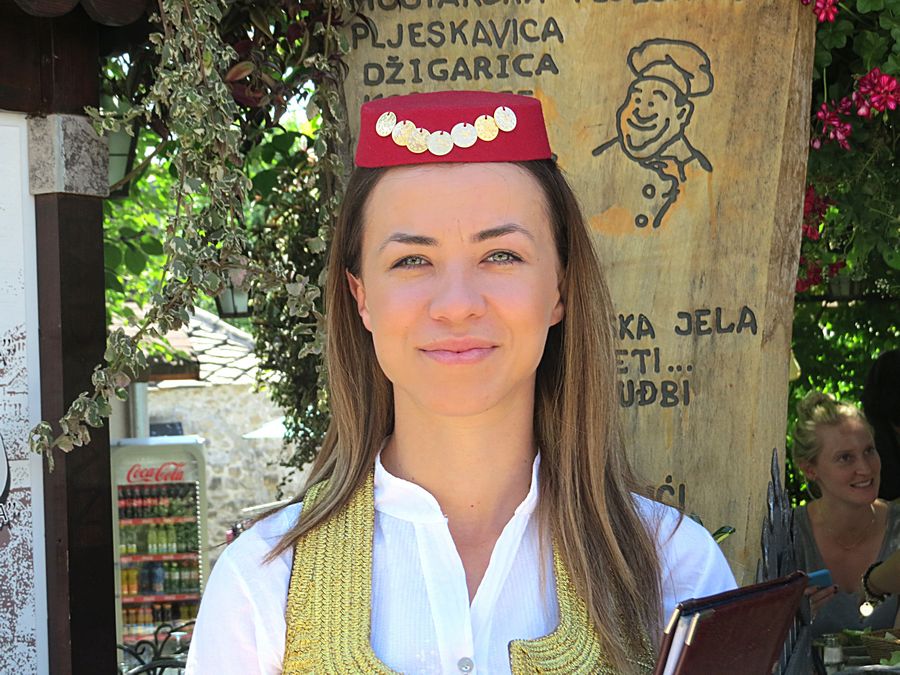
Waitress at the local restaurant where we had lunch
in Mostar. She is wearing a traditional costume.

A local father with his son. Is there any doubt they are father and son?
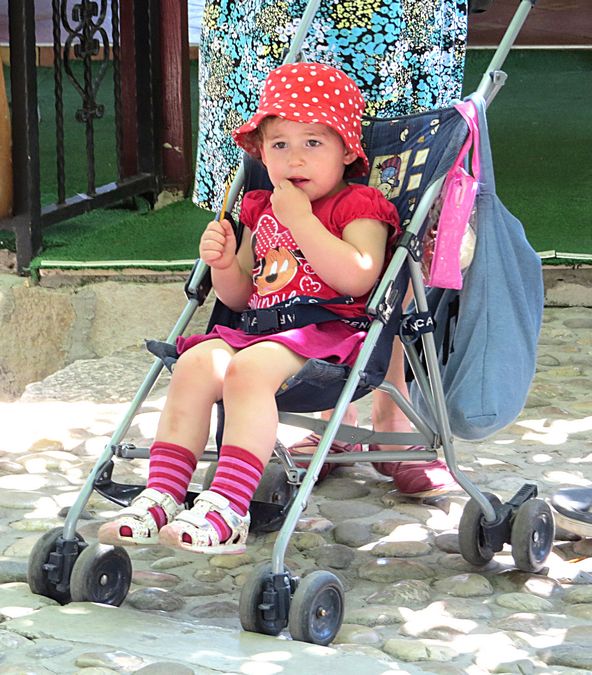
Mickey and Minnie Mouse seem to be popular around the world.
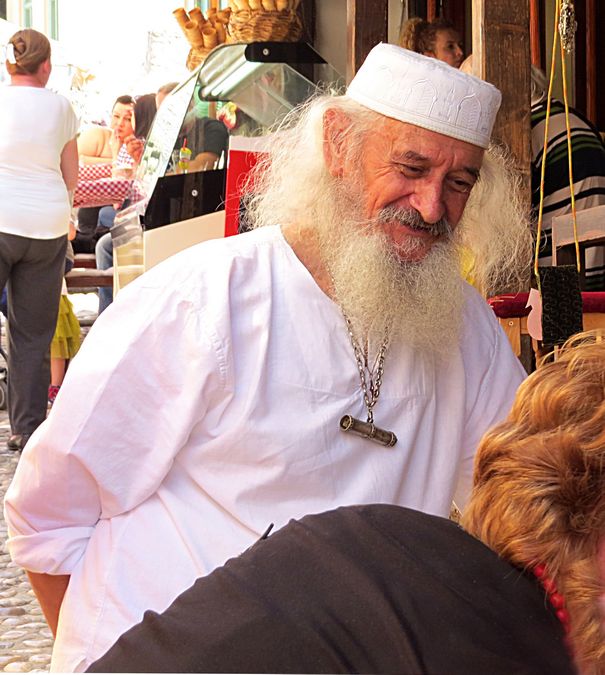


Not all buildings have been repaired from the 1990s war.
How would you like to have been living in this building during that time?
Through 1993 and 1994, when Bosniaks tried to go out, they
had to run past exposed places for fear of being shot by a sniper.
When people were killed, their corpses were sometimes left for months
as it wasn’t safe to try to retrieve the bodies.
So Bosniaks were victimized in Mostar by Croats,
just as Croats were victimized by Serbian and Montenegrin forces in Dubrovnik.

We drove from Mostar to the capital city of Bosnia and Herzegovina,
Sarajevo, seeing beautiful countryside scenery
along the way.
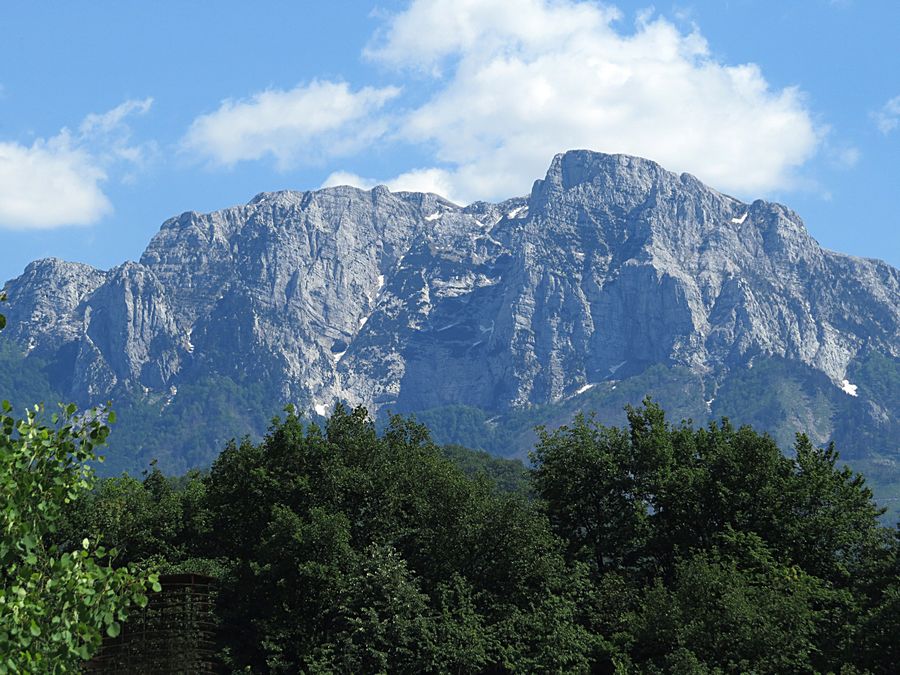

Upon arrival in Sarajevo, we took a short walk around the
neighborhood of our centrally located hotel. As elsewhere
in the Balkans, we frequently saw people buying and eating gelato.

View from my hotel room in Sarajevo with an ancient bazaar in the foreground.
This ancient building, Gaza Husrev-Bey Bezistan Bazaar, is in the heart
of the old town district of
Sarajevo Bascarsija,
and is at least five centuries old.
There are many specialty shops within it. Sarajevo is in a valley surrounded
by mountains, some of which you can see in the background.
Link to Page Eight - Sarajevo
Pat's Home Page